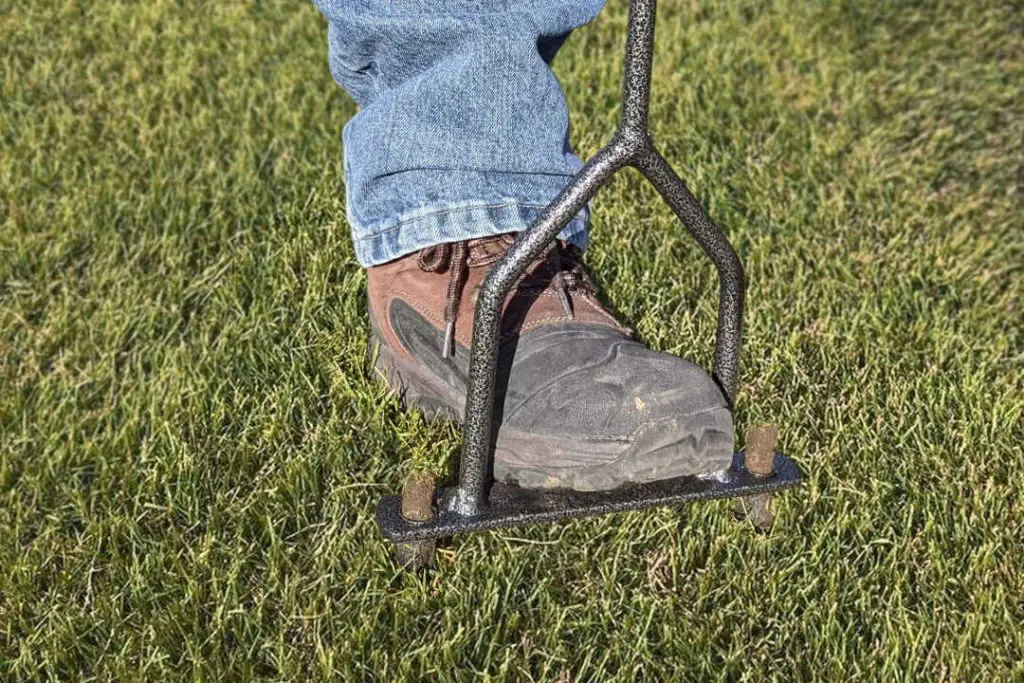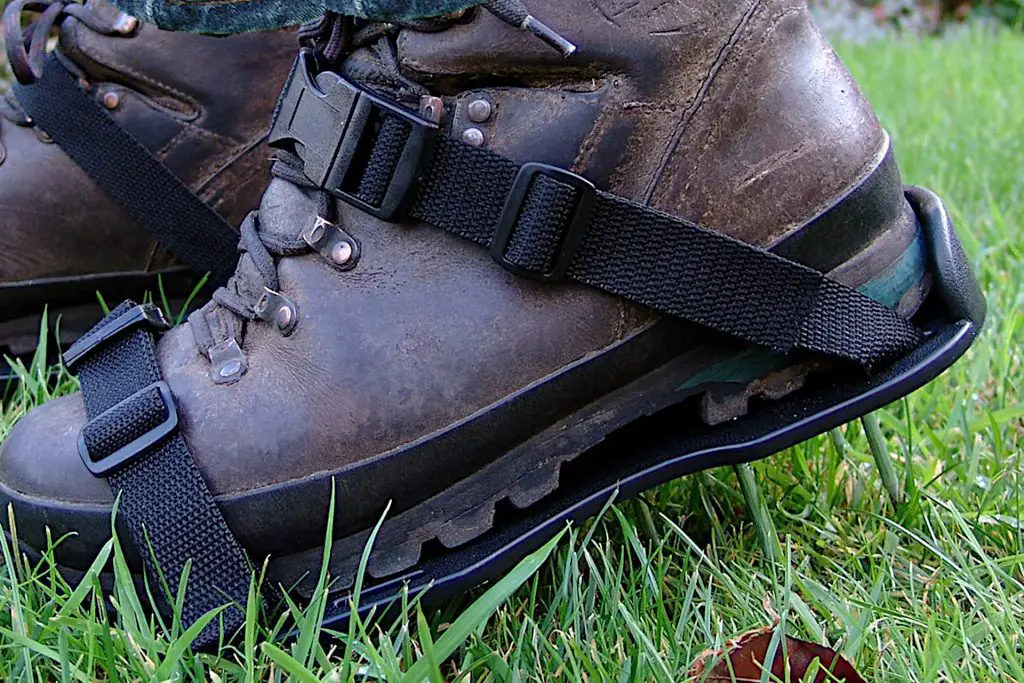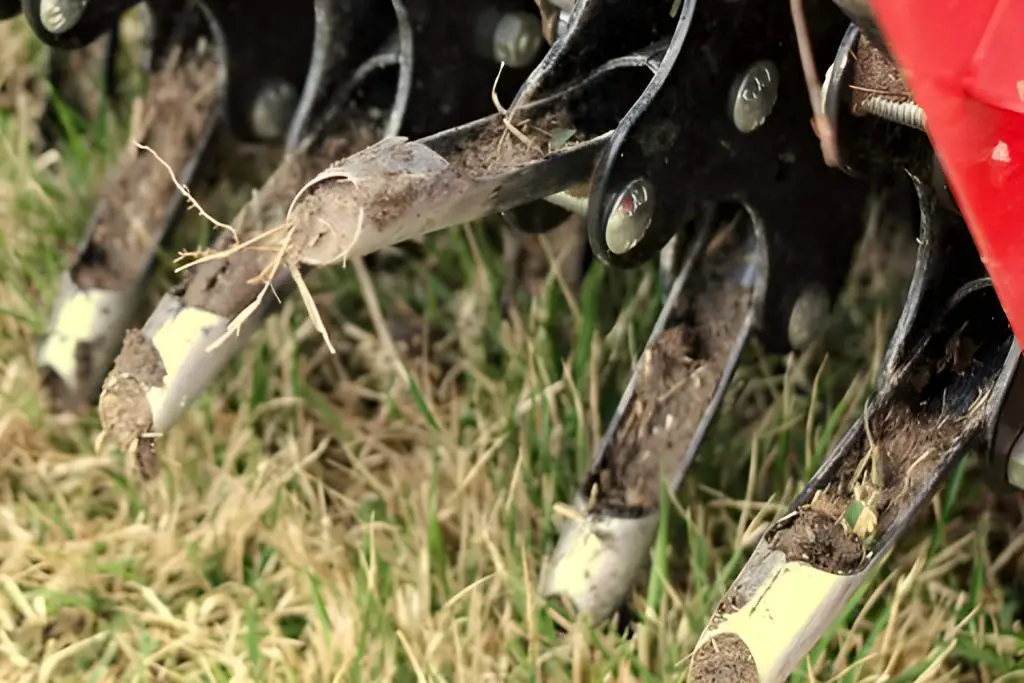From Garden Fork to Aerator – Aerating Lawn Correctly
Have you ever wondered how to cultivate a beautiful, green lawn? Then aerating a lawn is one of the best ways to help achieve this. Indeed, aerating the lawn is one of the most important and effective ways to achieve and maintain a healthy lawn. It will help remove thatch and enhance the flow of nutrients, water, and oxygen to the grass’s roots.
There are several options open to you when it comes to aerating such a a simple garden fork through to using a core/plug aerator. Your choice will depend on several factors, from the size of your lawn to the hardness of the soil to possibly how fit you feel if you want to use one of the various manual type of tools.
5 Key Benefits of Aerating Your Lawn
- Alleviate compacted soil: aerating reduces soil density helping the grass roots to penetrate deeper.
- Improves soil structure: The reduction in soil density with the addition of sand into the cores improves the soil structure and drainage.
- Improves root access to oxygen and water: Aerating allows the grass roots access to moisture and oxygen as both can grow deeper into the soil substrate.
- Manages to reduce thatch build-up: Thatch prevents the grass from accessing nutrients and can cause fungal infection. Aeration allows the micro-organisms in the soil to come to the surface and help decompose their thatch layer.
- Allows a thicker lawn to grow back: The improvement of soil structure drainage and access to the nutrients in the ground allows the grass to grow back thicker and stronger. This can be enhanced by overseeding.
What is Lawn Aeration?
Aeration is a process of opening cores in the soil. Each core is about a quarter to three-quarters of an inch in diameter and three to four inches deep (but can vary). You should aerate using a special aerating tool or forking a lawn using a communal garden fork.
Aeration opens the soil to allow air, water, and nutrients to penetrate deeper and relieve soil compaction. This aids in developing deeper roots, resulting in a more robust lawn.
Aerating a lawn is done when the soil becomes compacted from heavy foot traffic and mowing. When the soil becomes compacted, it prevents water from soaking in, air from penetrating it, and fertilizer from reaching the soil’s root zone. Soil compaction also prevents roots from growing deeply, thereby reducing the grass’s ability to produce food from photosynthesis.
Importance of timing of aeration:
In terms of timing, other factors need considering. When you aerate can also depend on the type of grass you have.
Generally, the best time to aerate your lawn would be in the fall, although this isn’t always the case and should depend on whether you have warm or cool-season grass. Fall is often preferred because it should ensure that it will be responsive to your efforts and allow the ground to recover from the process. When the grass is dormant, it is not recommended that you aerate it.
Because of this, cool-season grasses, such as fescue and bluegrass, should be aerated in the spring or fall when they are actively growing. Warm-season grasses, such as Bermuda and Zoysia, should be aerated in the late spring or early summer when they are actively growing.
Aerating your lawn at the right time will ensure that the grass can recover quickly and that the newly opened soil can absorb water and nutrients more efficiently.
How to know if your lawn needs aeration:
Lawns that have compacted soil tend to have a much higher thatch content. Too much lawn thatch or dense organic debris lying under the lawn’s surface may deprive the grassroots of vital nutrients. You should aerate as soon as it is evident that the soil has become compacted. If you have had particularly heavy footfall or increased your mowing, you should aerate it.
Aeration is a process used to relieve soil compaction, allowing air, water, and nutrients to penetrate the grass roots and help develop deeper roots. Your lawn may need aeration if you notice any of the following signs:
- The soil is hard to the touch and does not readily accept water or nutrients.
- Your lawn does not drain well after heavy rain, and you can see puddles of water on the surface.
- The grass appears thin, or there is a lack of growth.
- The lawn is less resilient to drought or heavy foot traffic than it once was.
- The grass has a dense layer of thatch.
Frequency of Aeration:
It is recommended that a lawn should be aerated at least once a year, ideally in the spring or fall. However, the frequency of aeration may vary depending on the type of grass and the level of foot traffic or usage the lawn receives. For example, a lawn that receives heavy foot traffic may need to be aerated more frequently, while a lawn with drought-resistant grass may be aerated less often. Additionally, if you notice that your grass has a high thatch layer or is experiencing issues with compaction, it may be necessary to aerate more frequently.
Different Types of Lawns:
Not all lawns have the exact needs, and it is essential to understand the specific needs of your lawn in order to maintain a healthy and vibrant landscape. For example, drought-resistant grasses such as Bermuda and Zoysia may require less water and may not need to be aerated as often. On the other hand, shade-tolerant grasses such as fescue may require more water and may benefit from aeration more frequently. Before aerating, check with a lawn care professional if you are unsure about the best action.
A Guide to Forking a Lawn
Any lawn, or grass area, whether a casual gathering spot for the family or a more formal part of the landscape, will benefit from being appropriately aerated. In times of drought or waterlogging, a well-aerated lawn will be more resilient and simpler to maintain and mow in the spring and summer.
Many articles will talk about choosing the type of aerator to use. Undoubtedly, you could use many good manual and mechanical aerators, both core, and spike. However, unless you have a specific need and provided that your lawn is manageable in size, the humble garden fork is a perfectly good tool for the operation.

Proper Use of a Garden Fork:
Aerating a lawn with a garden fork or a manual aerator may seem simple, but it is important to use the tool correctly to achieve the best results. First, make sure that the spikes on the fork are sharp and clean to ensure that they easily penetrate the soil.
Next, hold the fork at a slight angle and push it into the soil with your foot, careful not to damage the grass roots. The spikes should be inserted to a depth of about 3-4 inches, but this may vary depending on the soil and the type of grass. Try to be consistent in spacing the spikes to ensure that the entire lawn is aerated evenly.
Assessing Your Lawn
It’s especially crucial to pay attention to the parts of the lawn that see the most significant wear and tear, typically due to children’s activities and dogs’ movement over it, and that are particularly compacted.
As a result, before you begin, inspect the grass to determine what sort of condition it is in after the summer season. You’ll be able to decide when the grass is scant or stunted because of your visual cues.
Meanwhile, compaction may be present if you see pools of rainwater instead of the water being absorbed. However, you may also conduct a test by inserting a spike into the grass. There is undoubtedly a compacted layer if you find it difficult to push it more than a couple of inches at first, but you get less resistance below that.
Preparing the Lawn for Forking – Getting the Lawn Ready to Aerate
Ensure your lawn is in good shape and properly prepared before beginning the aeration procedure. Raking garbage, twigs, and leaves off the lawn is an integral part of the preparations. You should also cut your grass to make it simpler for the insects to penetrate. It is also important to remember to switch off your sprinklers if you have them before starting to aerate your lawn.
You should pay special attention to delicate regions. If you have portions of your lawn that attract more traffic than others, we suggest you pay particular attention to such areas. You may even go over these areas a second time to achieve the best possible result.
Aerator Shoes

Another option when manually aerating your lawn is to consider aerator shoes. These are simply shoes with spikes in the soles that plunge holes into the lawn as you walk about. I would however issue a word of caution if thinking about these. While the theory is great, unless you are careful it can be very easy to injure yourself using these if the spikes get stuck in the soil.
Timing Can Be Helpful when Spiking Your Lawn
An excellent time for aeration is after rainfall or watering (irrigation) as it is a much more difficult job on more complex ground, and the moisture will make the procedure much more straightforward. On the other hand, you don’t want the lawn to be too wet or waterlogged either.
When you are ready to start forking your lawn, start working the fork tines into the soil, repeat around every twelve inches, working up and down the lawn systematically.
Fill Holes With Sand
When you have finished spiking the soil, you can use sand to fill up the holes. This will significantly enhance drainage, particularly when you have heavy clay soils or if your grass is prone to becoming waterlogged. It is best to have no debris, as this will hinder drainage.
If you have especially heavy clay soil, consider adding calcium sulfate dihydrate (gypsum), as this can aid in the decompaction and improve the structure of clay soils.
If your soil is regular or light sandy, you can use a ready-mixed top treatment instead. This can help to smooth out any lumps or unevenness on the lawn’s surface.
Scarifying the Lawn
After you have completed aerating, an optional process is to scarify a lawn. You may want to do this because it will help to remove the thatch and moss from a lawn if the thatch and moss are more than a quarter of an inch thick in water, and any fertilizer you use may not be able to penetrate to the grassroots.
The best way to scarify is to use a rake, but if you have a vast lawn, you may need to use a dethatcher[1] or a powered scarifier.
Once you have finished these processes, the lawn might appear slightly thin, but by early spring, it will look very healthy.
Using a Motor Powered Aerator

A fork may be all that is required for many small-size domestic lawns, but with more extensive lawns, a fork is simply not enough to aerate your lawn and you will need a motorized aerator to be able to do the job properly. These can vary from manual devices resembling forks with a larger diameter or longer tines to push spike aerators or tow aerators.
If your soil is made from heavy clay, consider slicing aerators with rotating blades or using plug aeration instead of a spike, which will remove small cores of soil from the ground as it travels across the lawn.
What is Core/Plug Aeration?

Core aeration is a process that uses hollow tines to remove cores of soil, thatch, and grass from the surface of the lawn. The goals of core aeration are the same as those of spike aeration: to allow the roots of the grass to access nutrients more efficiently, provide better water penetration and circulation, and minimize compaction.
Because a plug aerator removes soil cores, rather than puncturing the surface of the ground, the process tends to have a much longer-lasting benefit. This means you are likely to need to aerate as frequently. In addition, where the soil is severely compacted or the ground is made from heavy clay, more than spike aeration may be needed to relieve the problem, and core aeration would be the solution.
Core aeration is carried out by using a plug aerator, these can be small machines that you push by hand to larger ride-on machines that can cover large areas quickly. Because of this, your watering and fertilizer efficiency will increase, ultimately resulting in healthier grass.
When you’re using an aerator machine, work over the grass in the same manner as you would while mowing; move in two different directions each time. In the summer, pay special attention to areas where children often play or where garden furniture is located. You will probably have to make several passes over the regions with the most compaction to get the best results.
The plugs the aerators dig out should be left on the surface, where they will gradually decompose back into the lawn’s soil.
What to Do After Aeration
After you’ve finished aerating your grass, let soil plugs or leftover dirt dry where they fall to avoid a weed infestation. They’ll break down in the rain or crumble when you next mow your lawn, bringing healthy soil and organic matter to the surface of your grass.
It is the ideal time for overseeding and fertilizing your lawn immediately after aeration. Where your aerator has made direct contact with the soil, it will allow seeds and nutrients to reach deep down into the ground directly, while roots will have new paths for the nutrients they need. When used together, it may assist in getting your lawn to look amazing quickly with good seed establishment and thicker, more lush grass growth.
Repairing Damage to Your Lawn After Aeration:
After aerating your lawn, you should take the opportunity to repair any damage that may have been caused. For example, if you notice any bare patches on the lawn, you can fill them in with grass seed or sod.
Even if not overseeding, you may need to add fertilizer or other nutrients to the soil to help the grass recover. Keeping the aerated area well-watered is also essential, and avoiding heavy foot traffic until the grass fully recovers.
Potential negative consequences of over-aeration:
Aerating your lawn is beneficial, but do just what is necessary. Over-aerating your lawn can lead to several negative consequences. For example, over-aerating can damage the roots of the grass and leave bare patches on the lawn.
Additionally, if the soil is aerated too frequently, it can lead to a buildup of thatch, as the grass clippings and other organic matter will not have a chance to decompose properly. Furthermore, over-aerating can also lead to soil erosion, as the soil structure will be less stable. It is essential only to aerate your lawn when necessary to prevent these adverse consequences and to follow proper aeration techniques.
Other Alternatives to Aeration:
Aeration is an effective way to improve the health of your lawn, but it is not the only way to achieve this. Other alternatives include topdressing, which involves adding a thin layer of soil or compost to the surface of the lawn. This can help to improve the soil structure and add key nutrients to the grass.
Overseeding involves adding new grass seed to an existing lawn, which can also help improve the grass’s density and health.
As we have discussed, fertilization can also play an important role in maintaining a healthy lawn. By understanding the specific needs of your lawn and using a combination of these methods, you can achieve a beautiful and lush landscape.
When there shouldn’t be holes in your lawn
Notes
- University of California, Agriculture and Natural Resources: When to dethatch? http://ipm.ucanr.edu/TOOLS/TURF/MAINTAIN/thatchtime.html
